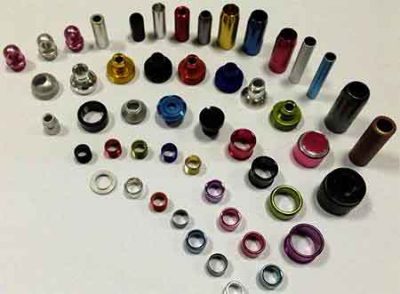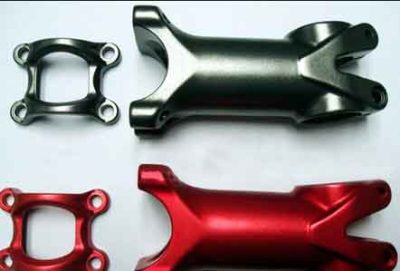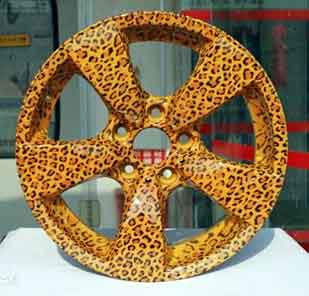Surface treatment is a process of artificially forming a surface layer on the surface of the prototype material that is different from the mechanical, physical and chemical properties of the substrate. The purpose of surface treatment is to meet the product’s corrosion resistance, wear resistance, decoration or other special functional requirements. For metal and plastic prototypes, our commonly used surface treatment methods are:
Mechanical polishing, chemical treatment, surface heat treatment, spray surface. Surface treatment is to clean, sweep, deburr, degrease, and deoxidize the surface of the prototype workpiece.

Tratamiento superficial de piezas mecanizadas CNC.

Plastic spraying of hardware products
1. Phosphating:
Phosphating is the process of treating the metal surface with an orthophosphate solution of manganese, zinc, iron and other metals to form an insoluble phosphate protective film. The protective film formed after the phosphating treatment can improve the insulation and corrosion resistance of the metal, improve the protection and decoration performance of the prototype workpiece, and can also be used as a good bottom layer of the coating. The metal surface phosphating treatment methods are divided into cold phosphating (normal temperature phosphating), thermal phosphating, spray-less phosphating and electrochemical phosphating. Phosphating treatment in the automobile industry is the main method for pre-coating painted parts such as automobile panels, cabs, and trunk panels. The phosphating film is required to be fine, smooth, uniform, moderate in thickness, and have certain heat resistance.

Injection of metal products
2. Sandblasting:
It uses compressed air as power to form a high-speed jet beam to spray the spray material (copper ore, quartz sand, emery, iron sand, sea sand) onto the surface of the workpiece to be processed at high speed. Due to the impact and cutting action of the abrasive on the surface of the workpiece, the surface of the workpiece obtains a certain degree of cleanliness and different roughness. The mechanical properties of the surface of the workpiece are improved, thereby improving the fatigue resistance of the workpiece, increasing the adhesion between the workpiece and the spray coating, extending the durability of the paint film, and also conducive to the leveling and decoration of the paint.
3. Spraying:
Surface painting is one of the most widely used surface processes. Spraying has the following advantages:
(1) It can cover the surface defects of the workpiece after forming;
(2) The surface of the workpiece can be sprayed to obtain a variety of colors, different gloss, different appearance and visual effects and a variety of different hand feelings;
(3) Enhance the hardness and scratch resistance of the workpiece surface;
The effects of spraying are:
Matte, semi-matte, gloss (alto brillo). Various colors, various textures, etchings, drawing effects (metal color can only be used for drawing), leather effects, elastic feel effects (rubber paint), etc..
Surface treatment process-spraying
4. Wire drawing:
Wire drawing is a surface treatment method that forms lines on the surface of the workpiece by grinding the product to achieve a decorative effect. Wire drawing can well reflect the texture of metal materials, and can make the metal surface obtain a non-mirror-like metallic luster. According to different surface effects, it can be divided into straight wire (hairline pattern) and chaotic wire (snow pattern).
The quality of silk pattern is very subjective. Each user has different requirements for surface lines and different preferences for line lines. Por lo tanto, it is necessary to have a wire drawing model to process the satisfactory results that users like. Circular arc (the intersection of arc and straight faces is very ugly and will draw unevenly).
5. Plastic spraying (dust spraying):
Electrostatic spraying uses the phenomenon of corona discharge to make the powder coating adsorb on the workpiece. The process is like this: The powder coating is sent to the spray gun by the powder supply system by compressed air gas, and the high voltage generated by the high voltage electrostatic generator is added to the front end of the spray gun. Due to corona discharge, a dense charge is generated near it. When the powder is ejected from the gun nozzle, it forms charged paint particles. It is attracted to the workpiece with the opposite polarity under the action of electrostatic force. As the amount of powder sprayed increases, the charge builds up. When it reaches a certain thickness, due to the electrostatic repulsion, the adsorption will not continue, so that the entire workpiece can obtain a certain thickness of powder coating. Then the powder is melted, leveled and solidified by heat, eso es, a hard coating film is formed on the surface of the workpiece.
Advantages and disadvantages of electrostatic spraying:
No need for thinner, no poison, no pollution, good coating quality, very high adhesion and mechanical strength, resistencia a la corrosión, short curing time, no primer, low technical requirements for workers, and high powder recycling rate;
But the coating is very thick, the surface effect is corrugated, not smooth, and it can only process the two appearance effects of semi-matte and bright.

Curved printing
6. Printing:
(1) Silk screen:
Disadvantages of silk screen: Screen printing mesh portion permeable to ink, stencil onto a substrate; The rest of the mesh on the printing plate is blocked and cannot penetrate the ink, forming a blank omission on the substrate. The mesh of the part where the ink is to be used on the printing plate is not closed, and the ink penetrates during printing, forming ink marks on the substrate. When printing, pour the ink into one end of the screen printing plate, and the ink will not leak on the substrate through the mesh without external force. When the ink is scraped with a squeegee at a certain inclination angle and pressure, the ink is transferred to the substrate under the screen through the screen, so as to achieve image reproduction. (The printed pattern is raised)
The advantages of silk screen printing:
A. Low cost and quick results.
B. Suitable for printing on irregular substrate surface.
do. Strong adhesion and good ink adhesion.
D. Thick ink layer and strong three-dimensional effect.
mi. Rotation resistance, strong optical rotation and good color forming.
F. Wide range of printing materials and large printing area.
(2) Pad printing (curved printing):
Refers to using a piece of flexible rubber to print the characters and patterns that need to be printed on the surface of a plastic molded product with curved or slightly concave and convex surfaces. In pad printing, the ink is first put into an intaglio plate with engraved characters or patterns, and then the characters or patterns are copied onto rubber, and then the rubber is used to transfer the characters or patterns to the surface of the plastic molded product. Finalmente, the ink is cured by heat treatment or ultraviolet light irradiation.
Surface treatment process-curved printing
7. Laser carving:
Laser carving is a process of surface treatment using optical principles. Por ejemplo, to make a keyboard, the words on it are blue, green, red and gray, and the keys are white. When laser engraving, first spray oil, blue, green, red, and gray with the corresponding color, so it looks like there are blue keys, green keys, etc., and then spray a layer of white as a whole. This is a whole white keyboard, and the blue and green are all wrapped underneath. Then use the laser technology and the button map submitted by the industrial designer to make the film, carved out the white oil on it, and the blue and green buttons are displayed.
Limitations of laser carving:
(1) Laser carving depth:
Aluminum is 0.1mm, plastic spray paint coating: 0.2-0.3milímetros, iron and other metals are up to 0.08mm;
(2) The limit surface area of laser carving is:
100X100mm, more than 100X100mm need to be spliced laser engraving, the position of the connection is not beautiful, and the connection trace is more obvious.
(3) White and nearly white colors cannot be removed by laser engraving, and the characters engraved by laser on the curved surface are prone to deformation.
 English
English العربية
العربية 中文(漢字)
中文(漢字) Čeština
Čeština Dansk
Dansk Nederlands
Nederlands Suomi
Suomi Français
Français Deutsch
Deutsch Italiano
Italiano 日本語
日本語 ಕನ್ನಡ
ಕನ್ನಡ 한국어
한국어 Português
Português Русский
Русский Slovenčina
Slovenčina Español
Español Svenska
Svenska Türkçe
Türkçe

